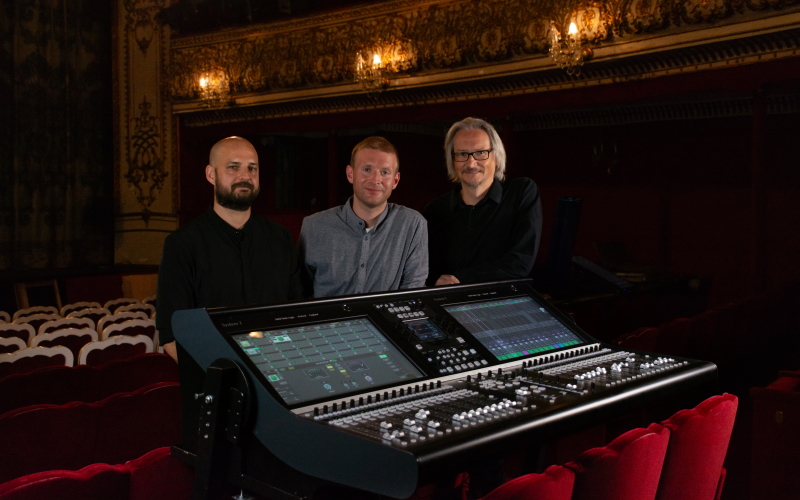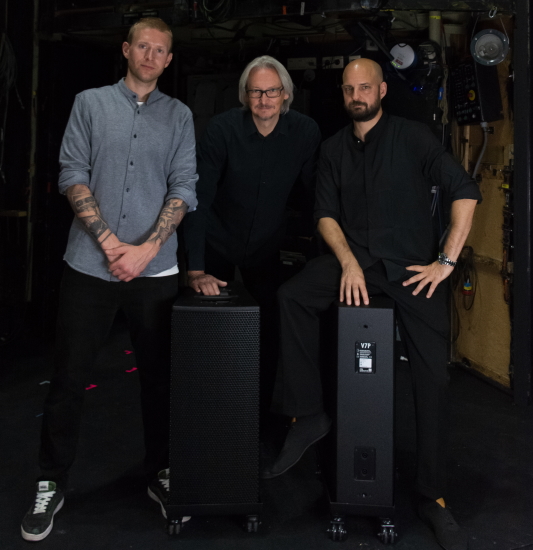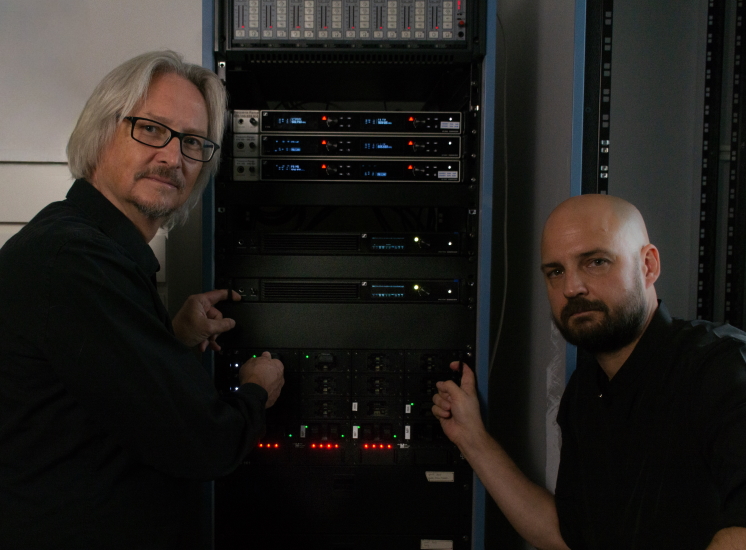Sound Technology at Theater in der Josefstadt
Pictures: © Annie Lehner

The Theater in der Josefstadt has brought its sound technology up to date and completely overhauled its central audio infrastructure. The focus is on the System-T digital mixing console from Solid State Logic (SSL), a state-of-the-art d&b loudspeaker system, and the world's first theater deployment of the innovative Sennheiser Spectera WMAS wireless system. The new systems were installed on the main stage and offer both top-of-the-line technical performance and a high degree of flexibility for artistic work. The picture above shows Raimund Hornich (Josefstadt), Thomas Haas (Josefstadt), and Mario Reithofer (TSAMM) on a SSL S500.
Founded in 1788 as a small stage to increase the business of a Pub, Theater in der Josefstadt was rebuilt to todays shape in 1822. The opening ceremony was conducted by Ludwig van Beethoven, writers and poets Ferdinand Raimund and Johann Nestroy performed as actors, King of walz, Johann Strauß performed with his orchestra. In 1924 the house was renovated under Max Reinhardt to todays red velvet and golden appearance. Raimund Hornich, Head of the Sound Department, particularly emphasizes the seamless compatibility between the Theater in der Josefstadt and its sister stage, the Kammerspiele:
"A major advantage of our new system is its complete interchangeability between the two venues. We could produce a play at the Kammerspiele and perform it on the main stage the next day, with virtually no technical adjustments. The workflows, the routing, the setups: everything remains virtually identical. This saves time, reduces sources of error, and creates planning security for both artistic and technical staff. A key factor in the system selection was the local sales partner TSAMM, led by Mario Reithofer, who closely oversaw the technical implementation of both theatres."
Since the sister Theatre, Kammerspiele, already uses two SSL SystemT, the Theater in der Josefstadt operates two SSL S500 surfaces, each with 34 faders, connected to an SSL Tempest processor – fully redundant. A custom-built trolley was developed for mobile applications in order to get one S500 Mixing Surface in and out the auditorim for rehearsals on daily basis. The system features 800 signal paths, which can be flexibly defined as inputs or outputs.
The fully Dante-based infrastructure uses I/O from SSL, DAD, Glensound, Sennheiser, d&B and Audinate and can be expanded at any time. Currently, approximately 800 inputs and outputs are in use. The first-class SSL preamps offer gain-compensated Dante playback. An additional remote unit with an additional sixteen faders allows the system to be operated throughout the theater. Two Apple mini Mac playback computers are connected via DAD AXCenter, each translating up to 256 Thunderbolt channels to Dante. Both computers run in parallel and can be switched between multi-channel configurations using a user button on the SSL or Stream Deck. A third AXCenter with MOM connects the Studio DAW.
In parallel with the upgrade of the mixing console system, the sound system at the Theater in der Josefstadt was also completely modernized. The newly installed d&b audiotechnik loudspeaker system ensures even, precise sound distribution throughout the entire auditorium, offering excellent speech intelligibility and musical brilliance. A central element of the new system are 62 installed loudspeakers, which enable a seamless, immersive sound experience. Raimund Hornich explains: "The loudspeakers are positioned to evenly cover the entire volume of the room – from the stalls to the backstage area. This allows us to achieve a spatially differentiated, transparent sound reproduction in every seat."

L-R: Thomas Haas, Mario Reithofer, Raimund Hornich
A long-held wish of the sound department was also realized during the redesign: "I was finally able to install a center cluster in the listed theater that blends harmoniously into the historic ambience while still preserving the hall's original charm," Hornich explains. "This central sound source enables more precise speech reproduction and improves the sonic balance for the entire audience without visually dominating the sound."
All d&b amplifiers feature integrated DSPs for comprehensive loudspeaker management, parametric EQs, filter functions, delay settings of up to 10 seconds per channel, and comprehensive interfaces for remote control and monitoring. Each channel accepts both analog and AES3 input signals, as well as Dante. These are complemented by features such as system check, input and load monitoring, surge protection, temperature-controlled ventilation, and highly efficient switching power supplies.
Hornich emphasizes: "The d&b amplifiers are the backbone of the entire PA system. They enable fine-tuned control, maximum reliability, and energy-efficient operation." To facilitate future compatibility with third-party systems, numerous plug-ins for common control platforms are also available. The sound system at the Theater in der Josefstadt features a clearly structured architecture, energy-efficient amplifier solutions, and differentiated room coverage. It is optimized for the complex acoustic requirements of a modern theater operation.
With the deployment of the Sennheiser Spectra WMAS wireless system (Wideband Multichannel Audio System), the Theater in der Josefstadt is breaking new international ground – as the first theater in the world to use this technology live. With Spectera, Sennheiser has launched a system specifically designed for live events and demanding audio productions. It utilizes WMAS broadband technology to efficiently control multiple wireless microphones and in-ear monitors within a shared frequency block. Of particular note is the uncompressed audio transmission, which enables exceptional sound quality without loss, even under demanding conditions.

L-R: Mario Reithofer, Raimund Hornich
Raimund Hornich explains: "WMAS enables the transmission of at least three audio channels per MHz, in practice often significantly more, depending on the available bandwidth. The technology uses wide frequency blocks, which makes transmission more robust against interference. A major advantage is the ability to dynamically adapt to user requirements, be it in terms of audio quality, latency, or reliability.
In contrast to narrowband systems, where each channel requires a narrow frequency range, WMAS transmits all audio channels together. This means more simultaneous connections, less interference, and significantly reduced coordination effort. This is a decisive advantage in environments with high radio density, such as festivals, TV studios, or even theaters." With Spectera, Sennheiser is setting a new standard in wireless audio technology, and the Theater in der Josefstadt is actively shaping this change.
By renewing its entire audio infrastructure, the Theater in der Josefstadt has consistently invested in powerful, flexible, and future-proof sound technology. The combination of the SSL System-T mixing console, the d&b loudspeaker system, and the Sennheiser Spectera WMAS wireless system enables a consistently digital workflow at the highest technical level, from wireless microphone transmission and signal routing to sound reinforcement.
The systems are precisely tailored to the theater's acoustic, spatial, and operational requirements and create optimal conditions for modern, efficient, and artistically diverse productions. Furthermore, special emphasis was placed on compatibility between venues, energy efficiency, and integration into existing network structures. The Theater in der Josefstadt is thus setting a strong example of technological excellence in the cultural sector and ensuring that future productions can also be realized under the best possible acoustic conditions.
www.josefstadt.org
www.tsamm.com
www.sennheiser.com
www.dbaudio.com
 How to resolve AdBlock issue?
How to resolve AdBlock issue?